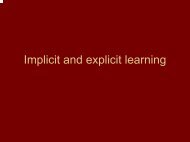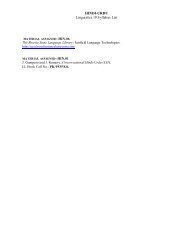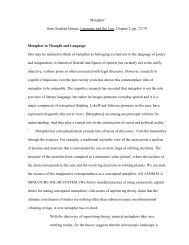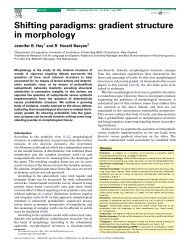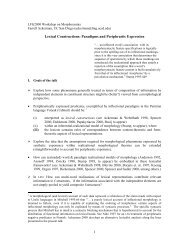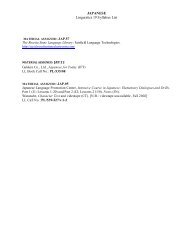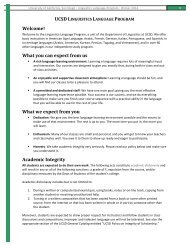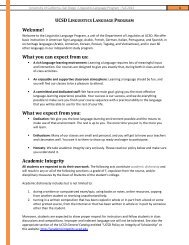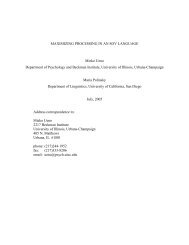Affricating ejective fricatives: The case of Tigrinya - Linguistics
Affricating ejective fricatives: The case of Tigrinya - Linguistics
Affricating ejective fricatives: The case of Tigrinya - Linguistics
You also want an ePaper? Increase the reach of your titles
YUMPU automatically turns print PDFs into web optimized ePapers that Google loves.
<strong>Affricating</strong> <strong>ejective</strong> <strong>fricatives</strong>: <strong>The</strong> <strong>case</strong> <strong>of</strong> <strong>Tigrinya</strong> 45and [ts’] pronunciations cannot be distinguished, at least in initial position (although Seyoum(2008) does not mention this variation). Sava Ÿ(2005: 23) reports that the <strong>ejective</strong> affricate/ts’/ in Ts’amakko has an <strong>ejective</strong> fricative [s’] as a free variant. In Lowland Oaxaca Chontal(Maddieson, Avelino & O’Connor 2009), /s’/ is realized as [ts’] or [ts/] with a few tokens <strong>of</strong>[s/] or[/s] (see Section 1.3.6 for more discussion).<strong>The</strong>re is also historical and dialectal evidence which may support the affricationhypothesis for <strong>Tigrinya</strong>. First, Steiner (1982) proposes that West Semitic ∗ Ṣ (Ṣade) should bereconstructed as a glottalized affricate [ts ] rather than a fricative, and Faber (1985) supportsand extends this position to Proto-Semitic. Reflexes <strong>of</strong> this sound appear as [ts] in ModernHebrew, as [s] in Arabic, and as [s’] in <strong>Tigrinya</strong>, e.g. [appleisa˘r] (Arabic) ‘enclosure’ [xats´r](Modern Hebrew) ‘enclosure, courtyard’, [appleas’´r´] (<strong>Tigrinya</strong>) ‘make a fence’. Arabicacquired secondary pharyngealization, whereas Hebrew lost glottalization. <strong>The</strong>se variablereflexes could stem from an affricate pronunciation <strong>of</strong> an <strong>ejective</strong> fricative. Second, ruraldialects <strong>of</strong> <strong>Tigrinya</strong> favor a palato-alveolar affricate [’] instead <strong>of</strong> [s’] in some lexical items:e.g. [appleas’´r´] ∼ [applea’´r´] ‘become short’, [k’ ˆns’i] ∼ [k’ ˆn’i] ‘flea’ or [s’´mm´r´] ∼[’´mm´r´] ‘add, unite’. Tigre cognates also occasionally have [’]: [’amra˘] ‘unite’or[k’ars’a˘] ∼ [k’ar’a˘] ‘slice, cut <strong>of</strong>f’ (<strong>Tigrinya</strong> [k’´r´s’´]) (Leslau 1987). Ullendorff (1955)and Voigt (1988) propose that this alternation is a type <strong>of</strong> palatalization due to influence fromrounded vowels by way <strong>of</strong> labial consonants, parallel to a [s ∼ S] alternation. Although theviability <strong>of</strong> the rounding trigger may be questioned, it is clear that [s’] alternates not with [S’],but with an affricate.Fre Woldu (1985) analyzed the properties <strong>of</strong> voiceless, voiced and <strong>ejective</strong> stops in<strong>Tigrinya</strong>, but not the <strong>ejective</strong> fricative /s’/. He found that the main characteristic <strong>of</strong> <strong>ejective</strong>stops, in relation to pulmonics, was a longer burst release followed by a period <strong>of</strong> silencepreceding the vowel. In perceptual experiments, native listeners reliably cued into this longsilent period in order to distinguish <strong>ejective</strong> and plain voiceless stops.Kingston (1985) analyzed larynx movement for <strong>Tigrinya</strong> stops. He observed 4–6 mm <strong>of</strong>laryngeal displacement during the <strong>ejective</strong> consonants but commented that larynx elevationis variable across speakers and is too slow and ill-timed with oral closure and release to fullyexplain the decreased volume <strong>of</strong> the oral cavity necessary for <strong>ejective</strong>s. No data on the <strong>ejective</strong><strong>fricatives</strong> <strong>of</strong> <strong>Tigrinya</strong> were reported.1.3 <strong>The</strong> phonetics <strong>of</strong> <strong>ejective</strong> <strong>fricatives</strong>: A cross-linguistic perspectiveIn this section we present observations about <strong>ejective</strong> <strong>fricatives</strong> in those languages where thesounds have been described instrumentally.1.3.1 AmharicDemolin (2002, 2004) reports the main acoustic, aerodynamic, and articulatory characteristics<strong>of</strong> the <strong>ejective</strong> fricative /s’/ in Amharic, a South Ethio-Semitic language closely related to<strong>Tigrinya</strong>. 5 <strong>The</strong> duration <strong>of</strong> the <strong>ejective</strong> fricative, both singleton and geminate, is alwaysshorter than that <strong>of</strong> the plain fricative. <strong>The</strong> frication noise <strong>of</strong> a plain fricative has constantamplitude, but for <strong>ejective</strong>s there is a gradual increase in amplitude during constriction, and12 ms (geminate) or 30 ms (singleton) <strong>of</strong> glottal lag before vowel onset that is not presentin pulmonic <strong>fricatives</strong>. <strong>The</strong>re is no discussion <strong>of</strong> a preceding silent interval characteristic<strong>of</strong> affrication, though there is one example <strong>of</strong> a recorded <strong>ejective</strong> fricative whose waveformis characterized by a (nearly) silent interval (Figure 4 in Demolin 2002: 469). Intraoral airpressure was measured using a small plastic tube inserted through the nasal cavity into theoro-pharynx, and oral airflow was measured using a silicone rubber mouthpiece, both pieces<strong>of</strong> equipment connected to a Physiologia workstation (Bucella et al. 2000: 449–450; Teston& Galindo 1990). Intraoral air pressure for the <strong>ejective</strong> rises rapidly with a dramatic decrease5 UPSID-PC (Maddieson & Precoda 1991) reports only <strong>ejective</strong> affricates for Amharic.



